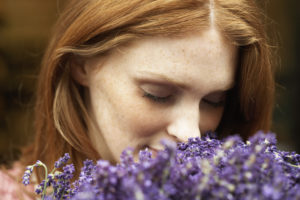To fully immerse our audience in the worlds and settings we craft for them in our self-published novels, it’s important to let readers engage all their senses. A while ago, we presented the first part of this article, in which we covered sight and sound; today we’ll discuss touch, smell, and taste.
Touch
Our heroes often find themselves in unusual situations. After all, the whole point of us creating these adventures is to help our readers escape reality. This often means they are touching or coming into physical contact with unusual or repellent objects, things that our readers have probably always tried to avoid touching.
A great way to enhance your description of touch is to focus on the physical reaction it evokes. Your hero’s skin might crawl or become covered in goosebumps; they might faint or feel ill.
The use of adjectives will also help you with your descriptions of touch.
 Smell
Smell
Smell and taste (below) are probably the hardest senses to represent in our writing. The first thing to do is to decide what feeling you want to create in your readers.
Smell links us to our past. Use its associations to help describe the conditions under which a scene is taking place. A bad smell in a horror story usually forebodes a gruesome occurrence. The smell of smoke is an indicator of danger.
Taste
Try and associate taste with textures. Think about various flavors and see if you can come up with a texture to represent it. This will help our readers appreciate exotic, alien, or repulsive flavors they have never experienced before.
Here are the classifications of taste along with a few words and textures they might be paired with:
• Bitter: tart / vinegary
• Salty: briny / brackish
• Sour: tart / acerbic
• Sweet: saccharine / syrupy
• Savory: aromatic / wholesome
• Metallic: bloody / rusty
Bringing all Five Together (and Adding More!)
Skilled writers will be able to combine all five of these senses to really bring their story to life. The rule of thumb is: the longer your description, the more senses you should engage. You can even try to incorporate other sensations, such as our kinesthetic sense and our balance (our kinesthetic sense is the awareness of our body and the position of our body parts, and our balance relates to our physical stability). These are good senses to tap during fight scenes.
Archway Publishing is always looking for content for its blog. If you’re an Archway Publishing author and would like to share a guest blog post, please visit our Blog Guidelines Page.
